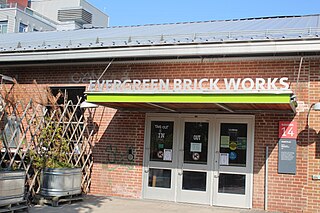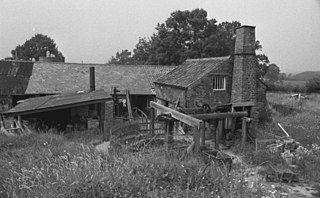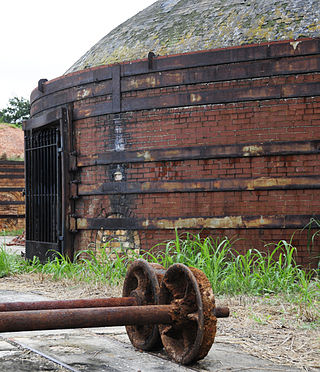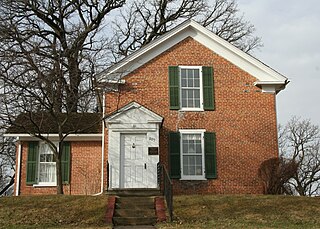
A brick is a type of construction material used to build walls, pavements and other elements in masonry construction. Properly, the term brick denotes a unit primarily composed of clay, but is now also used informally to denote units made of other materials or other chemically cured construction blocks. Bricks can be joined using mortar, adhesives or by interlocking. Bricks are usually produced at brickworks in numerous classes, types, materials, and sizes which vary with region, and are produced in bulk quantities.

The Don Valley Brick Works is a former quarry and industrial site located in the Don River Valley in Toronto, Ontario, Canada. The Don Valley Brick Works operated for nearly 100 years and provided bricks used to construct many well-known Toronto landmarks, such as Casa Loma, Osgoode Hall, Massey Hall, and the Ontario Legislature. Since the closure of the original factory, the quarry has been converted into a city park which includes a series of naturalized ponds, while the buildings have been restored and opened as an environmentally focused community and cultural centre by Evergreen, a national charity dedicated to restoring nature in urban environments.

The United States National Arboretum is an arboretum in northeast Washington, D.C., operated by the United States Department of Agriculture's Agricultural Research Service. It was established in 1927 by an act of Congress after a campaign by USDA Chief Botanist Frederick Vernon Coville.

Barrow Haven is a hamlet and small port in North Lincolnshire, England. It was the site of a former ferry crossing that spanned from the Humber Estuary to Hull, serving as a place for ships and boats crossing the Humber to moor away from the tidal flow. A port continues to exist nearby and the area's rail access is based at the Barrow Haven railway station, a stop on the Barton Line.

The Claybank Brick Plant National Historic Site, located near Claybank, Saskatchewan at the foot of the Dirt Hills in the RM of Elmsthorpe No. 100, was an operational brick manufacturing plant from 1914 to 1989. Bricks manufactured at the site have been used to construct prominent Canadian buildings such as the Bessborough Hotel in Saskatoon and the Chateau Frontenac in Quebec City. The site was designated as a National Historic Site in 1996 and remains one of Canada's greatest examples of early twentieth century industrialism.

Dorchester Pottery Works is a historic site at 101-105 Victory Road in Dorchester, Massachusetts, a neighborhood of Boston. The Dorchester Pottery Works was founded in 1895 by George Henderson and made stoneware. The Dorchester Pottery Works closed in 1979. The building was designated as a Boston Landmark in 1980 and added to the National Register of Historic Places in 1985.

The Dorchester-Milton Lower Mills Industrial District is a historic district on both sides of the Neponset River in the Dorchester area of Boston and in the town of Milton, Massachusetts. It encompasses an industrial factory complex, most of which was historically associated with the Walter Baker & Company, the first major maker of chocolate products in the United States. The industrial buildings of the district were built between about 1868 and 1947. They were listed as part of the district on the National Register of Historic Places in 1980, with a slight enlargement in 2001. The buildings have been adapted for mixed industrial/retail/residential use.

The Continental Clay Brick Plant in Martinsburg, West Virginia includes a number of beehive brick kilns. Originally a coal-fired brickworks, it was later converted to natural gas. The kilns are now largely disused, except for a few used to dry sand.
The Belden Brick Company is an American manufacturer and distributor of brick and masonry-related construction products and materials. Founder, Henry S. Belden, chartered the company in Canton, Ohio as the 'Diebold Fire Brick Company' in 1885 on the Belden farm. The Belden Family belongs to the Weatherhead School of Management Family Business Hall of Fame at Case Western Reserve and the Company is one of the largest family owned brick manufacturers in the U.S.

The Engine House No. 18 is a fire station located at 3812 Mt. Elliott Avenue in Detroit, Michigan. It is also known as Engine Company No. 18 Fire Station. It is the third oldest existing fire station in Detroit. The station was listed on the National Register of Historic Places in 1995.
Brickworks is Australia's largest brick manufacturer, consisting of four divisions – Building Products Australia, Building Products North America, Industrial Property, and Investments.

Wetheriggs Pottery is a former pottery on the C3047 road, east of the hamlet of Clifton Dykes, in Clifton, Cumbria, 5 miles (8.0 km) southeast of Penrith in England. It opened in the mid 19th century providing farm and housewares for local consumption, later the business diversified into craft pottery. The property is Grade II listed.

The Birch Creek Charcoal Kilns are a group of beehive-shaped clay charcoal kilns near Leadore, Idaho, built in 1886. They were listed on the National Register of Historic Places in 1972.

Guignard Brick Works is a historic industrial site and national historic district located in Cayce, Lexington County, South Carolina. The brick works was established by the Guignard family in 1801 and over the years produced brick for many buildings in Columbia, South Carolina and throughout the South. The complex includes four brick beehive kilns, a historic brick office, and remnants of other industrial features of the brick works. Three of the four remaining kilns were built around 1920, the other was built in 1932. Clay for brickmaking was obtained from banks of the nearby Congaree River.

The Orville P. and Sarah Chubb House is a historic house in Fairmont, Minnesota, United States. Built in 1867, the Chubb House is the oldest residence standing in Fairmont, and the only surviving house known to have been built with brick from Fairmont's first brickyard. It was the home of prominent homesteader Orville Chubb, who was the community's first physician. The house is an example of a property associated with the early Yankee American development of southern Minnesota town sites. The house was listed on the National Register of Historic Places in 1995 for having local significance in the theme of exploration/settlement. It was nominated for its connections to the founding of Fairmont and for representing the Yankee settlement of southern Minnesota towns.

The Moses King Brick and Tile Works is a historic brickworks located at 738 North Coal Street in Colchester, Illinois. The complex includes King's Folk Victorian home, four of the original seven beehive kilns, the factory building and its drying tunnels, two exhaust stacks, and various outbuildings. Moses King established the brickworks on his own land, which held one of the county's richest clay deposits, in 1881. The brickworks was a major part of Colchester's clay industry, which developed as a way of using excess coal from the city's more prominent coal mining industry; it eventually became one of the city's main economic drivers, along with coal and the railroad. While coal and clay both declined in Colchester in the twentieth century, the brickworks survived as a producer of buff brick, ultimately becoming the last surviving brickworks in the city. It closed in the 1960s when buff brick declined in favor of colored brick, which could be more easily obtained from other sources.

The Brickworks Museum, also known as Bursledon Brickworks, is a volunteer-run museum in Swanwick, Hampshire, England. It is purportedly the UK's sole surviving Victorian steam-driven brickworks.

The Lithgow Valley Colliery and Pottery Site is a heritage-listed former pottery and colliery and now pottery and visitor attraction at Bent Street, Lithgow, City of Lithgow, New South Wales, Australia. It was built from 1876 to 1945. It is also known as Lithgow Pottery and Brickworks. The property is privately owned. It was added to the New South Wales State Heritage Register on 2 April 1999.
Chaska brick is a distinctive brick known for its unique cream color, high clay content, and quality, originating in Chaska, Minnesota, United States. The Chaska brick industry flourished from 1857 until 1950. First called "Chaska brick" in an 1894 Chaska Herald article, this product remains closely tied to the history of the city from which it came.

















